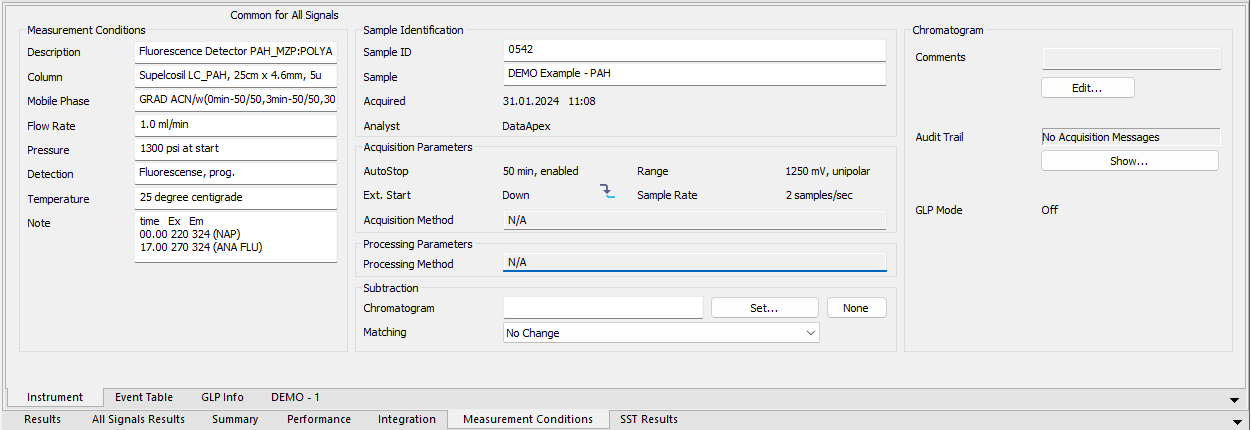Measurement
Displays the conditions under which the chromatogram was measured. Once selected, the Measurement Conditions tab will be displayed in the lower part of the Chromatogram window, containing
This sub-tab is common to all signals in given chromatogram.
The following fields in the Measurement Conditions section are designated for the information purposes only and can be filled in or left blank according to your choice.
Description - brief description of method.
Column - description of the column used.
Mobile Phase - description of mobile phase.
Flow Rate - description of flow rate.
Pressure - description of pressure.
Temperature - description of temperature.
Note - any comment primarily connecting to the method.

Chromatogram - Measurement Conditions
Fields from the header of the analysis - Single Analysis dialog or the relevant row of the Sequence Table in the Sequence window.
Sample identifier. This corresponds to the Sample ID field from the Single Analysis dialog or the Sample ID column from the Sequence window.
Description of the sample. This corresponds to the Sample field from the Single Analysis dialog or the Sample column from the Sequence window.
Date and time of the end of the measurement. If the date is not accessible (e.g. in some imports), N/A will be displayed.
Name of the user who measured the analysis.
Parameters of measurement common for all signals. The remaining parameters can be found on the Method Setup - Measurement tab.
Notifies whether the Enable Autostop checkbox was used and what was the Run Time value set.
Specifies whether and by what change on the relevant input the measurement was started. This corresponds to the External Start/Stop section of the Method Setup - Measurement tab.
Name of the method used for measurement.
Specifies the range of the detector signal used. If more than one detector was used to gather data with different Ranges set (including signal units), the <varies> inscription will be displayed here.
Specifies the sampling rate of the detector used. If more than one detector was used to gather data with different Sampling Rate set, the <varies> inscription will be displayed here.
Parameters of processing method for all signals.
Name, version and date of the method used for processing.
Sets the automatic subtraction of selected chromatogram. Subtraction of the chromatogram (e.g. solvent) is indicated by the note Mathematically reprocessed in the printed report. The use of automatic subtraction is also logged into the chromatogram audit trail.
There are two places in Clarity where the subtraction chromatogram can be set - Method Setup - Advanced tab (for the newly created chromatograms) accessible from the
The subtracted chromatogram has to be always present in the defined path. The change in the subtracted chromatogram influences the resulted subtraction in the current chromatogram.
If the chromatogram being subtracted has different number of signals than the method, only the signals present both in the method and in the subtracted chromatogram will be subtracted.
Note:
In the Data Acquisition window, the subtracted chromatogram may be displayed during a measurement in the background as a grey chromatogram. To display the chromatogram in the background without automatic subtraction (e.g., the solvent) use the File - Set Background Chromatogram… command.
Field specifying the file with subtraction chromatogram.
Displays the Open Chromatogram dialog used for selecting the subtracted chromatogram.
Cancels subtraction of chromatogram.
Selects the subtraction method.
No change - The chromatogram is subtracted from the measured chromatogram without any additional adjustments.
Offset Subtraction Chromatogram - “Offsets” the measured chromatogram with the subtraction chromatogram by shifting it on the axis X (time axis) before the actual subtracting.
Scale Subtraction Chromatogram -“Scales” the measured chromatogram before subtracting by scaling the subtraction chromatogram on the time axis.
Note:
Alignment of chromatograms is achieved using the biggest peaks in the subtraction chromatogram, i.e. either to the highest peak or to the peak with the largest area.
Chromatogram
Section that contains the additional information on the sample or chromatogram.
This button serves for adding some information about the chromatogram or additional info on the sample in the Comments dialog. The button also allows to modify the comment entered prior to the analysis from the Single Analysis or Sequence dialog. This field can then be added to the report setup on the Report Setup - Results tab
Using the Show button allows to display the Chromatogram Audit Trail dialog containing the log of events happening with the given chromatogram.
Event Table
This tab shows the setting of the Event Table defined in the method on the Method Setup - Event Table tab. It is common for all signals in case of the multi-detector chromatogram. More information on the Event Table is in the chapter "Event Table"
This tab shows the list of control modules (hardware) configured on the instrument and used for the acquisition of the chromatogram, along with the serial numbers of this hardware. The contents of this tab may be added to the printed reports by checking the GLP Info checkbox on the Report Setup - Method tab.
The tab displaying detailed measurement parameters. In the case of a multi-detector chromatogram there is a tab for every detector in the configuration of the Instrument.
Tab displaying the injection method of the autosampler.
Tab displaying instrument method of gas or liquid chromatograph.